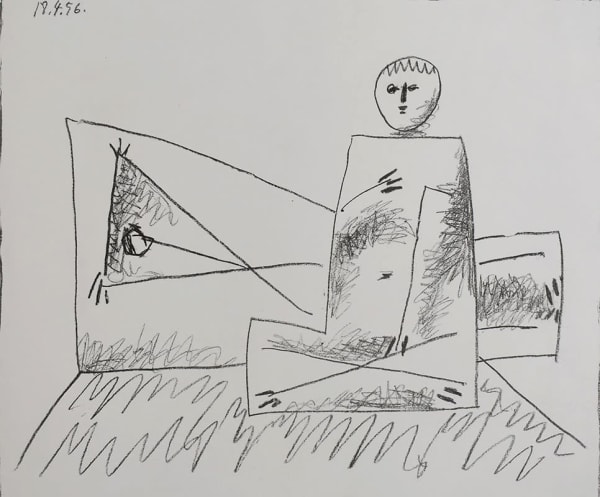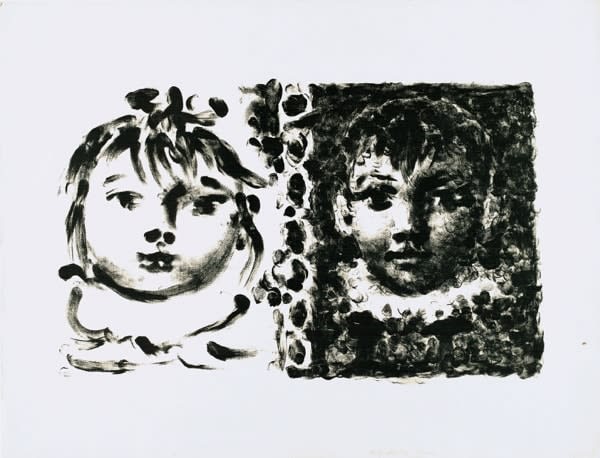
Pablo Picasso
Signed and numbered
65.2 x 50.0 cm
Le Corsage à carreaux (The Checkered Blouse) is a powerful lithograph created by Pablo Picasso in March 1949. This striking portrait—marked by its haunting frontal gaze, rich tonal variation, and rhythmic surface patterning—is one of Picasso’s most evocative explorations of the female figure through the print medium. In this work, the artist fuses classical solemnity with modern abstraction, using the tools of lithography not only to render form, but to build atmosphere, psychological depth, and graphic complexity.
The composition is dominated by a monumental female head rendered with chiaroscuro intensity. Her gaze is direct and unwavering, framed by long, dark, textured hair that merges into the background. The face, built from dense black lines and velvety tonal passages, evokes the timeless solemnity of a Byzantine icon or an Egyptian stela. There is a sculptural stillness to her form, as if chiseled into the print surface rather than drawn upon it.
Below the figure’s face and shoulders, the titular corsage à carreaux—a blouse with a checkered or diamond pattern—fills the bottom half of the composition. It is executed not with naturalistic detail but through a lattice of criss-crossing diagonal lines, filled with erratic marks, dots, and scribbles. This area of abstracted surface treatment stands in stark contrast to the precision of the face above, adding a dynamic tension to the image. The blouse becomes both a textile and a field of graphic energy—almost a net, veil, or coded writing that insulates or conceals the woman beneath.
The black-and-white palette, along with the smudged, painterly textures and calligraphic flourishes, reveals the full range of Picasso’s lithographic vocabulary. His manipulation of the greasy litho crayon, tusche washes, and scratching tools transforms the stone into a painterly surface capable of immense variation and subtlety.
By 1949, Picasso was deeply immersed in portraiture—particularly in the depiction of women, lovers, and muses, among them Françoise Gilot, who was his partner during this period. While Le Corsage à carreaux is not necessarily a direct likeness, it reflects Picasso’s interest in fusing observation with invention. The figure here is at once idealized and introspective—a woman of strength, mystery, and composure.
The contrast between the sacred, serene face and the abstract grid of her garment suggests a tension between identity and representation, inner life and outer form. This aligns with broader themes in Picasso’s work: the idea of the woman not as a passive object of beauty, but as a subject of unknowable interiority.
The checkered blouse itself may function symbolically—referring to costume, social role, or domesticity. Yet in Picasso’s hands, it becomes a surface for artistic invention, transforming pattern into psychological architecture.
Picasso’s work in lithography, particularly during the 1940s and 1950s, reveals his full embrace of the medium’s expressive possibilities. Unlike etching or aquatint, lithography allowed him to draw directly onto the stone, preserving the immediacy of gesture while enabling richly layered tonal effects. At the Atelier Mourlot in Paris, he produced hundreds of lithographs, experimenting with both technical approaches and narrative possibilities.
Le Corsage à carreaux is a prime example of this mastery. The composition’s deep blacks, soft greys, and dynamic linework demonstrate how Picasso could use lithography not as a reproductive medium but as a true extension of his artistic language—simultaneously painterly, sculptural, and graphic.
Le Corsage à carreaux is a profound meditation on form, identity, and emotional presence. With its stark contrasts and subtle elegance, the work stands as a testament to Picasso’s ability to elevate printmaking into the realm of psychological portraiture. Through lithography, he achieves not just a likeness, but a living surface—a face that stares back, quiet and eternal, from the layered depths of the stone.
For more information, contact our galleries via the inquiry form below.
-
 Pablo PicassoJacqueline Profile to the Right, 1958
Pablo PicassoJacqueline Profile to the Right, 1958 -
 Pablo PicassoLes Demoiselles d'Avignon, 1953
Pablo PicassoLes Demoiselles d'Avignon, 1953 -
 Pablo PicassoBuste au fond étoilé (Bust with Star Background), 1949
Pablo PicassoBuste au fond étoilé (Bust with Star Background), 1949 -
 Pablo PicassoJeu De La Cape (Bloch 1015), 1961
Pablo PicassoJeu De La Cape (Bloch 1015), 1961 -
 Pablo PicassoTete De Femme Fond Noir, 1946
Pablo PicassoTete De Femme Fond Noir, 1946 -
 Pablo PicassoBuste de Femme au Corsage Blanc (Jacqueline de Profil), 1957
Pablo PicassoBuste de Femme au Corsage Blanc (Jacqueline de Profil), 1957 -
 Pablo PicassoReclining Man and Crouching Woman | Homme couché et femme accroupie, 1956
Pablo PicassoReclining Man and Crouching Woman | Homme couché et femme accroupie, 1956 -
 Pablo PicassoThe Little Artist (Draughtsman) | Le petit dessinateur, 1954
Pablo PicassoThe Little Artist (Draughtsman) | Le petit dessinateur, 1954 -
 Pablo PicassoGrand Maternite, 1963
Pablo PicassoGrand Maternite, 1963 -
 Pablo PicassoFrançoise Sur Fond Gris, 1950
Pablo PicassoFrançoise Sur Fond Gris, 1950 -
 Pablo PicassoFemme à L'Italienne d'après le tableau de Victor Orsel (Bloch 740), 1953
Pablo PicassoFemme à L'Italienne d'après le tableau de Victor Orsel (Bloch 740), 1953 -
 Pablo PicassoGrand Nature Mort au Compotier, 1947
Pablo PicassoGrand Nature Mort au Compotier, 1947 -
 Pablo PicassoAfter The Embrace, 1901
Pablo PicassoAfter The Embrace, 1901 -
 Pablo PicassoProfil de Femme
Pablo PicassoProfil de Femme -
 Pablo PicassoProfil au fond noir, 1947
Pablo PicassoProfil au fond noir, 1947 -
 Pablo PicassoRonde de la Jeunesse, 1961
Pablo PicassoRonde de la Jeunesse, 1961 -
 Pablo PicassoFemme à la Robe
Pablo PicassoFemme à la Robe -
 Pablo PicassoJacqueline with Roses, 1956
Pablo PicassoJacqueline with Roses, 1956 -
 Pablo PicassoPaloma et Claude, 1950
Pablo PicassoPaloma et Claude, 1950 -
 Pablo PicassoBuste, 1957
Pablo PicassoBuste, 1957 -
 Pablo PicassoPortrait de Femme II, 1955
Pablo PicassoPortrait de Femme II, 1955 -
 Pablo PicassoTête de Jeune Fille – Portrait de Françoise, 1949
Pablo PicassoTête de Jeune Fille – Portrait de Françoise, 1949 -
 Pablo PicassoJeunesse, 1950
Pablo PicassoJeunesse, 1950
Join our mailing list
* denotes required fields
We will process the personal data you have supplied in accordance with our privacy policy (available on request). You can unsubscribe or change your preferences at any time by clicking the link in our emails.
This website uses cookies
This site uses cookies to help make it more useful to you. Find out more about cookies.






















